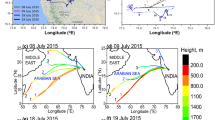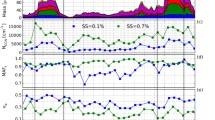Abstract
A field study was conducted at a mountain-top site in northwestern Colorado. Supercooled cloud water, collected as a function of droplet size, was analyzed for anions, cations and trace elements. Enrichment factors (EF) of SO 2−4 , K+, Na+ and Cl− relative to crustal and marine reference elements (Al and Na) were calculated to determine whether chemical fractionation of the aerosol occurs during cloud droplet formation. The largest EF's for all ions were found for droplets less than 10–15 µm diameter. Ratios of the small to large droplet mean EF's ranged from 1 to 2, for SO 2−4 relative to both Al and Na+, to 10 to 12 for Na+, Cl− and K+, relative to Al. EF's of K+ and Cl− in the bulk cloud water were in crustal and marine proportions, respectively. It was concluded that although bulk could chemistry may indicate a lack of enrichment of a species, this may not be true throughout the droplet size distribution. The higher enrichments in small droplets is likely a result of their formation on small aerosol particles whereas the large droplets form on the largest aerosol particles. This may suppress EF's in precipitation relative to the total aerosol.
Similar content being viewed by others
References
Borys, R. D., Lowenthal, D. H., and Rahn, K. A., 1986, Contributions of smelters and other sources to pollution sulfate at a mountaintop site in northwestern Colorado. In R. Pielke (ed.),Acid Deposition in Colorado — A Potential or Current Problem; Local versus Long-distance Transport into the State, Colorado State Univ., Ft. Collins, Colorado, pp. 167–174.
Borys, R. D., Hindman, E. E., and Demott, P. J., 1988, The chemical fractionation of atmospheric aerosol as a result of snow crystal formation and growth,J. Atmos. Chem. 7, 213–239.
Borys, R. D., 1992, A comparison of cloud droplet and ice particle chemistry: The estimation of aerosol chemistry from the composition of snow,Tellus, in press.
Fuzzi, S. and Waldvogel, A., 1989, European Aerosol Conference, September 1989, Vienna Austria Workshop: Fog and Cloud Research,J. Aerosol Sci. 21 (3), 339–344.
Heintzenberg, J. A., Ogren, J. A., Noone, K. J., and Gärdneus, L., 1989, The size distribution of submicrometer particles within and about stratocumulus cloud droplets on Mt. Åreskutan, Sweden,Atmos. Res. 24, 89–101.
Hindman, E. E., Borys, R. D., and DeMott, P. J., 1983, Hydrometeorological significance of rime ice deposits in the Colorado Rockies,Water Res. Bull. 19, 619–624.
Hindman, E. E., Carter, E. J., Borys, R. D., and Mitchell, D. L., 1992, Collecting supercooled droplets as a function of droplet size,J. Atmos. Ocean. Tech. 9, 337–353.
Hudson, J. G., 1984, Cloud condensation nuclei measurements within clouds,J. Climate Appl. Meteorol. 23, 42–51.
Lovett, G. M. and Reiners, W. A., 1983, Cloud water: An important vector of atmospheric deposition, in H. R. Pruppacher, R. G. Semonin and W. G. N. Slinn (eds.),Precipitation Scavenging, Dry Deposition and Resuspension, Vol 1, Elsevier, Amsterdam, pp. 171–180.
Linkletter, G. O. and Warburton, J. A., 1976, A note on the contribution of rime and surface hoar to the accumulation on the Ross Ice Shelf, Antarctica,J. Glaciol. 17, 351–354.
Mason, B., 1966,Principles of Geochemistry, 3rd edn., Wiley, New York.
Munger, J. W., Collett, J. Jr., Daube, B. Jr., and Hoffmann, M. R. 1989, Chemical composition of coastal stratus clouds: Dependence on droplet size and distance to the coast,Atmos. Environ. 23 (10), 2305–2320.
Noone, K. J., Charlson, R. J., Covert, D. S., Ogren, J. A., and Heintzenberg, J., 1988, Cloud droplets: Solute concentration is size dependent,J. Geophys. Res. 98, 9477–9482.
Ogren, J. A., Heintzenberg, J., Zuber, A., Noone, K. J., and Charlson, R. J., 1989, Measurements of the size-dependence of solute concentrations in cloud droplets,Tellus 41B, 24–31.
Pruppacher, H. R. and Klett, J. D., 1978,Microphysics of Clouds and Precipitation, D. Reidel, Dordrecht.
Pytkowicz, R. M. and Kester, D. R., 1971, The physical chemistry of sea water,Oceanogr. Mar. Biol. Ann. Rev. 9, 11–60.
Rahn, K. A., 1975a, The chemical composition of the atmospheric aerosol: A compilation I,Extern,IV 12, 286–313.
Rahn, K. A., 1975b, The chemical composition of the atmospheric aerosol: A compilation II,Extern,IV 12, 639–667.
Rahn, K. A., 1976, The chemical composition of the atmospheric aerosol. Tech. Rep., Grad. School of Ocean., Univ. of Rhode Is., Kingston, RI 02881.
Rahn, K. A. and McCaffrey, R. J., 1979, Compositional differences between arctic aerosol and snow,Nature 280, 479–480.
Warburton, J. A. and Linkletter, G. O., 1977, Precipitation forming mechanisms and the chemistry of precipitation on the Ross Ice Shelf, Antarctica,IAHS, publication No. 118, 88–94.
Author information
Authors and Affiliations
Rights and permissions
About this article
Cite this article
Carter, E.J., Borys, R.D. Aerosol-cloud chemical fractionation: Enrichment factor analysis of cloud water. J Atmos Chem 17, 277–292 (1993). https://doi.org/10.1007/BF00694401
Received:
Issue Date:
DOI: https://doi.org/10.1007/BF00694401




